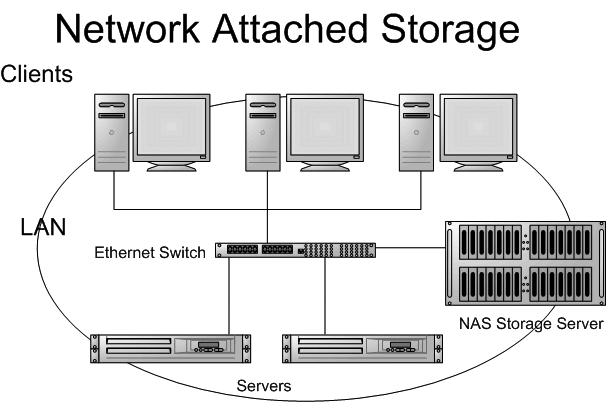
“Network-attached storage (NAS) is file-level computer
data storage connected to a computer network providing data access
to heterogeneous clients.” If that sounds too technical then
in layman’s language a NAS is simply a server that is dedicated to
nothing more than file sharing.
Simply speaking using a traditional LAN protocol such as TCP/IP over Ethernet, the NAS enables additional storage to be quickly added by plugging it into a network hub or switch.
NAS
does not provide any of the activities that a server in a
server-centric system typically provides, such as e-mail,authentication
or file management,however these services maybe later added as a
add-on.
So why do we need a NAS:

Well just consider a business that has more than one employee and that
has tonnes of data in its server,if that business decides to move from
one location to other,then it has to take all its data with it. It
would be really great option if all this data was centralized and could
be accessed from anywhere but for a small business that option is not
a practical one considering the cost of a file server, or an
additional license of Windows server 2003,or a support license of Linux
for that matter. Now this is where the NAS steps in to provide a
reliable and cheap solution to your data-storage needs.They often
include built-in features such as disk space quotas, secure
authentication, or the automatic sending of email alerts should an error
be detected.
So how does a NAS work:
Well traditionally like a file servers, NAS follows a client-server design. A single hardware device, often called the NAS box or NAS head,
acts as the interface between the NAS and network clients.These
devices run on an embedded OS . Single or multiple hard drives can be
connected to a NAS . A client usually connects to the NAS head and not
directly to the storage device, a client often connects using Ethernet
connection,and thus a NAS appears as a single ‘node’ in the network
often the IP address of the NAS device.With a NAS device, storage is
not an integral part of the server. Instead, in this storage-centric
design, the server still handles all of the processing of data but a
NAS device delivers the data to the user. A NAS device does not need
to be located within the server but can exist anywhere in a LAN.
Communication with the NAS head occurs with TCP/IP . The two file-based protocols most commonly associated with NAS are Sun Network File System (NFS) and Common Internet File System (CIFS).
NFS was developed for UNIX based systems to transfer files over LAN.
The CIFS was formerly known as Server Message Block (SMB). SMB was
developed by IBM and Microsoft to support file sharing in DOS.
Many NAS systems today support HTTP as a protocol to enable you to browse content using the browser.
Other Network protocols used to serve NAS:
Why is NAS cheaper :
Well a NAS is cheaper because of various factors like it runs a stripped-down operating system,often FreeNAS. And at the same time it offers very limited services when compared to a full-fledged file-server.
If you are considering to buy a NAS for yourself you may consider
paying a visit to following reviews of NAS by PC magazine and CNET.
http://www.pcworld.com/article/125072/top_10_networkattached_storage_devices.html
http://reviews.cnet.com/best-network-attached-storage/
